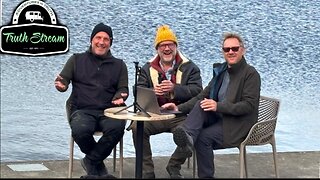Premium Only Content

Minnesota School of the Air: Adventures in Music – Each Its Own Voice: Saxophone
Setting: A classroom-style radio broadcast, likely aired in the 1940s or early 1950s, designed for Minnesota schoolchildren listening in schools or homes. The episode creates an engaging atmosphere, possibly evoking a jazz club, concert hall, or band room to highlight the saxophone’s versatility.
Plot/Content:
Introduction: The episode opens with a narrator or music teacher introducing the saxophone, invented by Adolphe Sax in the 1840s, and its unique role as a woodwind instrument with a single reed and conical bore, producing a warm, expressive tone. The narrator might explain its “voice-like” quality, which blends the clarity of a clarinet with the richness of a brass instrument, making it ideal for both solo and ensemble roles. Minnesota’s connection to music education, including its strong school band programs, could be noted to ground the lesson locally.
Historical Context: The narrator provides a brief history, mentioning the saxophone’s early use in military bands, its prominence in 1920s jazz (e.g., by artists like Sidney Bechet), and its growing presence in classical music (e.g., works by composers like Debussy or Glazunov). The episode might highlight the saxophone’s rise in popularity during the 1940s, driven by big bands (e.g., Glenn Miller) and emerging bebop artists (e.g., Charlie Parker).
Musical Examples: The program features live or pre-recorded saxophone performances, likely by a soloist or small ensemble (e.g., saxophone with piano or a quartet), showcasing the instrument’s range across genres. Possible pieces include:
A jazz standard like “Sweet Georgia Brown” or “Take the ‘A’ Train,” demonstrating the saxophone’s improvisational flair in swing or bebop, with a tenor or alto sax lead.
A classical piece like an excerpt from Marcel Mule’s arrangements or a simplified version of Glazunov’s Saxophone Concerto, highlighting the instrument’s lyrical side.
A popular tune from the era, such as a Glenn Miller-style big band piece (e.g., “In the Mood”), showing the saxophone’s role in dance music.
Educational Segments: Between performances, the narrator explains the saxophone’s construction (e.g., brass body, key system) and its four main types (soprano, alto, tenor, baritone), possibly with brief demonstrations of each. The episode might describe how the saxophone’s sound is produced (reed vibration, embouchure) and its expressive techniques, like vibrato or growling, as noted in modern saxophone pedagogy. The narrator could also discuss the instrument’s role in school bands, encouraging students to try it, especially given Minnesota’s robust band programs in cities like Minneapolis and St. Paul.
Interactive Element: In line with the program’s educational approach, the narrator might invite students to mimic the saxophone’s sound vocally (e.g., humming a jazzy melody) or ask questions for classroom discussion, such as “How does the saxophone’s sound differ from a clarinet’s?” or “What emotions do you hear in the saxophone’s music?” Teachers might be encouraged to follow up with band demonstrations or local music activities.
Conclusion: The episode closes with a reflection on the saxophone’s unique “voice,” emphasizing its ability to convey emotion in jazz, classical, and popular music. The narrator might mention local saxophone players or Minnesota’s contributions to jazz (e.g., the Twin Cities’ growing jazz scene in the 1940s) and encourage students to explore the instrument in school bands or community ensembles. A final performance, possibly a lively jazz riff or a soulful ballad, leaves listeners inspired by the saxophone’s versatility.
Themes: The individuality of musical instruments, the saxophone’s cultural significance, and the joy of musical expression. The episode aims to spark curiosity about the saxophone and its role in American music, particularly in Minnesota’s educational and cultural landscape.
Cast and Roles:
Narrator/Teacher: An unnamed KUOM staff member or music educator (possibly E.W. Ziebarth, a known KUOM broadcaster), delivering historical context and commentary with a clear, engaging tone for young listeners. The narrator guides the lesson, explaining the saxophone’s mechanics and cultural role.
Musical Performers: Unnamed saxophonists and accompanists, likely local Minnesota musicians, University of Minnesota students, or faculty, performing solo or ensemble pieces. A skilled alto or tenor saxophonist would lead, possibly with piano or rhythm section (drums, bass) for jazz pieces, or a classical ensemble for concert works. Performers are uncredited, as was typical for KUOM’s educational broadcasts.
Supporting Roles: No dramatic characters, but the narrator might adopt a lively tone to mimic a jazz musician or read song lyrics to evoke the saxophone’s expressive quality.
Note on Cast: Minnesota School of the Air prioritized content over performer credits, and musicians were often sourced from the University’s music department or Twin Cities talent, ensuring authentic but simple arrangements. The involvement of University of Minnesota faculty, like those later associated with saxophone pedagogy (e.g., Eugene Rousseau, who joined in 2000), is unlikely for this earlier period but reflects the region’s saxophone expertise.
Production Details:
Music: Saxophone performances, arranged for educational purposes, featuring solo or small ensemble formats (e.g., saxophone with piano or rhythm section). The Adventures in Music series used modest instrumentation to suit radio and classroom settings, with selections drawn from jazz standards, classical repertoire, or popular music of the era.
Director/Producer: Likely overseen by KUOM staff, such as Burton Paulu (station manager) or Judith Waller (program director), who shaped the School of the Air curriculum.
Writer: Script likely written by a KUOM educator or music faculty member, drawing on music education texts or contemporary saxophone resources, tailored for young listeners.
Sponsor Funded by the University of Minnesota and possibly state education grants, with no commercial sponsorship, as KUOM was a non-commercial station.
-
 8:11
8:11
MattMorseTV
17 hours ago $17.65 earnedTrump's DECLARATION of WAR.
30.8K81 -
 3:44
3:44
GritsGG
15 hours agoUpdate Your Warzone Loadouts w/ These Tips!
12.7K1 -
 2:31:01
2:31:01
The Connect: With Johnny Mitchell
18 hours ago $15.16 earned"It's About To Get Worse"- CIA Agent Andrew Bustamante Explains Why It's Time To Leave America
21.3K31 -
 36:28
36:28
TruthStream with Joe and Scott
1 day agoMark Attwood joins TruthStream in Ireland by the lake to discuss all things from Crowley to Ireland to UFOs
14.2K32 -
 2:13:30
2:13:30
Side Scrollers Podcast
1 day agoUK Introduces MANDATORY Digital ID + Dallas ICE Shooting BLAMED on Gaming + More | Side Scrollers
200K63 -
 LIVE
LIVE
Lofi Girl
2 years agoSynthwave Radio 🌌 - beats to chill/game to
123 watching -
 2:26:44
2:26:44
Tundra Tactical
9 hours ago $19.91 earned🎉 Pro-2A Party LIVE! | Zeke Stout Joins The Show With Tacoma Tactical
28.4K1 -
 2:36:47
2:36:47
BlackDiamondGunsandGear
11 hours agoAFTER HOURS ARMORY / The LEFT are Recruiting / Join the Leftist Gun Club?
16.5K8 -
 16:07
16:07
Ken LaCorte: Elephants in Rooms
15 hours ago $5.11 earnedWhy firefighting got political
27.3K8 -
 8:31
8:31
Rethinking the Dollar
20 hours agoBitcoin Secrets Nobody Talks About!
17.9K8